A Supercapacitor-Based Method to Mitigate Overvoltage and Recycle the Energy of Pantograph Arcing in the High Speed Railway
Abstract
:1. Introduction
2. Overvoltage Phenomenon of Pantograph Arcing
2.1. Description of the Traction System
2.2. Model of the Pantograph Arcing
2.3. Mechanism of the Overvoltage Phenomenon of the Pantograph Arcing
2.4. Simulation of the Overvoltage Phenomenon of Pantograph Arcing
3. Proposed Method to Mitigate the Overvoltage
3.1. Proposed Circuit
3.2. Bidirectional Converter
3.3. Supercapacitor-Based Energy Storage System
3.4. Simulation Results of the Proposed Circuit
4. Performance Comparisons with Other Methods
5. Conclusions
Author Contributions
Funding
Acknowledgments
Conflicts of Interest
References
- Wu, G.; Wu, J.; Wei, W.; Zhou, Y.; Yan, Z.; Gao, G. Characteristics of the Sliding Electric Contact of Pantograph/Contact Wire Systems in Electric Railways. Energies 2018, 11, 17. [Google Scholar]
- Tellini, B.; Macucci, M.; Giannetti, R.; Antonacci, G.A. Conducted and Radiated Interference Measurements in the Line-Pantograph System. IEEE Trans. Instrum. Meas. 2001, 50, 1661. [Google Scholar] [CrossRef]
- Wang, W.G.; Wu, G.N.; Gao, G.Q.; Wang, B.; Cui, Y.; Liu, D.L. The Pantograph-catenary Arc Test system for High-speed Railways. J. China Railw. Soc. 2012, 30, 22. [Google Scholar]
- Midya, S.; Bormann, D.; Larsson, A.; Schutte, T.; Thottappillil, R. Understanding pantograph arcing in electrified railways—Influence of various parameters. In Proceedings of the 2008 IEEE International Symposium on Electromagnetic Compatibility, Detroit, MI, USA, 18–22 August 2008; pp. 1–6. [Google Scholar]
- Lu, Y.T.; Chen, G.X.; Yang, H.J.; Zhang, S.D. Effect of the Inclination Angle of a Carbon Strip on Friction and Wear Behavior of Carbon Strip /Pure Copper Contact Wire at a High Speed. Lubrication Eng. 2011, 36, 19–22. [Google Scholar]
- Wang, Y.; Liu, Z.G.; Fan, F.Q.; Gao, S.B. Review of Research Development of Pantograph-catenary Arc Model and Electrical Characteristics. J. China Railw. Soc. 2013, 35, 35–43. [Google Scholar]
- Gao, G.; Hao, J.; Wei, W.; Hu, H.; Zhu, G.; Wu, G. Dynamics of Pantograph–Catenary Arc During the Pantograph Lowering Process. IEEE Trans. Plasma Sci. 2016, 44, 11. [Google Scholar] [CrossRef]
- Hao, J.; Gao, G.; Wu, G. Dynamic Analysis of Pantograph-catenary Arc During the Pantograph Lowering Process. In Proceedings of the 2016 IEEE International Conference on High Voltage Engineering and Application (ICHVE), Chengdu, China, 19–22 September 2016. [Google Scholar]
- Liu, Z.; Zhou, H.; Huang, K.; Song, Y.; Zheng, Z.; Cheng, Y. Extended Black-Box Model of Pantograph-Catenary Detachment Arc Considering Pantograph-Catenary Dynamics in Electrified Railway. IEEE Trans. Ind. Appl. 2019, 55, 776–785. [Google Scholar] [CrossRef]
- Galdi, V.; Ippolito, L.; Piccolo, A. Arcing in AC railways: A mathematical approach. WIT Trans. Built Environ. 1998, 37. [Google Scholar] [CrossRef]
- Peng, K.; Gao, G. The Influence of Power Factor and Traction Current on Pantograph-catenary Arc Energy. In Proceedings of the 2016 IEEE International Conference on High Voltage Engineering and Application (ICHVE), Chengdu, China, 19–22 September 2016. [Google Scholar]
- Ma, L.; Marvin, A.; Karadimou, E.; Armstrong, R.; Wen, Y. An Experimental Programme to Determine the Feasibility of Using a Reverberation Chamber to Measure the Total Power Radiated by an Arcing Pantograph. In Proceedings of the 2014 International Symposium on Electromagnetic Compatibility (EMC Europe 2014), Gothenburg, Sweden, 1–4 September 2014. [Google Scholar]
- Ma, L.; Wen, Y.; Marvin, A.; Karadimou, E.; Armstrong, R.; Cao, H. A Novel Method for Calculating the Radiated Disturbance from Pantograph Arcing in High-Speed Railway. IEEE Trans. Veh. Technol. 2017, 66, 10. [Google Scholar] [CrossRef]
- Wei, W.; Wu, J.; Gao, G.; Gu, Z.; Liu, X.; Zhu, G.; Wu, G. Study on Pantograph Arcing in a Laboratory Simulation System by High-Speed Photography. IEEE Trans. Plasma Sci. 2016, 44, 10. [Google Scholar] [CrossRef]
- Geise, R.; Kerfin, O.; Neubauer, B.; Zimmer, G.; Enders, A. EMC Analysis Including Receiver Characteristics -Pantograph Arcing and the Instrument Landing System. In Proceedings of the 2015 IEEE International Symposium on Electromagnetic Compatibility (EMC), Dresden, Germany, 16–22 August 2015. [Google Scholar]
- Radojević, Z.M.; Terzija, V.V.; Djuric, M.B. Numerical Algorithm for Overhead Lines Arcing Faults Detection and Distance and Directional Protection. IEEE Trans. Power Deliv. 2000, 15, 1. [Google Scholar] [CrossRef]
- Gao, G.; Yan, X.; Yang, Z.; Wei, W.; Hu, Y.; Wu, G. Pantograph–Catenary Arcing Detection Based on Electromagnetic Radiation. IEEE Trans. Electromagn. Compat. 2018, 99, 1–7. [Google Scholar] [CrossRef]
- He, D.H. Test Method of Arcing Behaviour for Railway Current Collection System. In Proceedings of the World Congress on Railway Research, Cologne, Germany, 25–29 November 2001. [Google Scholar]
- Kim, W.-I.; Lee, K.-S.; Jung, N.-G.; Koo, K.-W.; Kim, J.-M. Analysis of the Pantograph Arcing on the Railway Vehicle. In Proceedings of the 20th International Conference on Electrical Machines and Systems (ICEMS), Sydney, NSW, Australia, 11–14 August 2017; pp. 1–4. [Google Scholar]
- Xu, C.D.; Cheng, K.W.E.; Zou, Y.; Wang, X.L.; Raman, S.R.; Xue, X.D. Electromagnetic Scattering of High Power Traction Transformer in High Speed Railway Based on FEM. In Proceedings of the 2016 International Symposium on Electrical Engineering (ISEE), Hong Kong, China, 14 December 2016. [Google Scholar]
- Lu, H.; Zhu, F.; Liu, Q.; Li, X.; Tang, Y.; Qiu, R. Suppression of cable overvoltage in a high-speed Electric multiple units system. IEEE Trans. Electromagn. Compat. 2018, 99, 1–11. [Google Scholar] [CrossRef]
- Wang, Q.; Zhu, F.; Liu, Q.; Li, X.; Tang, Y.; Qiu, R. Transient overvoltage study of auto-passing neutral section in high-speed railway, Transportation Electrification Asia-Pacific (ITEC Asia-Pacific). In Proceedings of the 2017 IEEE Conference and Exp, Harbin, China, 7–10 August 2017. [Google Scholar]
- Achouri, F.; Achouri, I.; Khamliche, M. Protection of 25Kv electrified railway system. In Proceedings of the 2015 4th International Conference on Electrical Engineering (ICEE), Boumerdes, Algeria, 13–15 December 2015; pp. 1–6. [Google Scholar]
- Li, T.; Wu, G.; Zhou, L.; Gao, G.; Wang, W.; Wang, B.; Liu, D.; Li, D. Pantograph arcing’s impact on locomotive equipment. In Proceedings of the 2011 IEEE 57th Holm Conference on Electrical Contacts (Holm), Minneapolis, MN, USA, 11–14 September 2011; pp. 1–5. [Google Scholar]
- Wang, W.G. Experimental study on electrical characteristics of pantograph arc. Low Voltage Elect. App. 2012, 6, 5–10. [Google Scholar]
- Gao, G.; Zhang, T.; Wei, W.; Hu, Y.; Wu, G.; Zhou, N. A pantograph arcing model for electrified railways with different speeds. J. Rail Rapid Transit 2018, 232, 1731–1740. [Google Scholar] [CrossRef]
- Habedank, U. On the mathematical-description of arc behavior in the vicinity of current zero. EtzArchiv 1988, 10, 339–343. [Google Scholar]
- Deblecker, O.; Bertrand, P.; Versèle, C. Study of auxiliary railway power supply facing catenary transient overvoltage. In Proceedings of the 2009 35th Annual Conference of IEEE Industrial Electronics, Porto, Portugal, 3–5 November 2009. [Google Scholar]
- Delfino, F.; Procopio, R.; Rossi, M. Overvoltage protection of light railway transportation systems. In Proceedings of the 2003 IEEE Bologna Power Tech Conference Proceedings, Bologna, Italy, 23–26 June 2003; Volume 4. [Google Scholar]
- Yusu, W.; Liu, Y.; Gao, G.; Wu, G. Influence of grounding mode on surge voltage in the process of pantograph rising for high speed train. In Proceedings of the 2016 IEEE International Conference on High Voltage Engineering and Application (ICHVE), Chengdu, China, 19–22 September 2016. [Google Scholar]

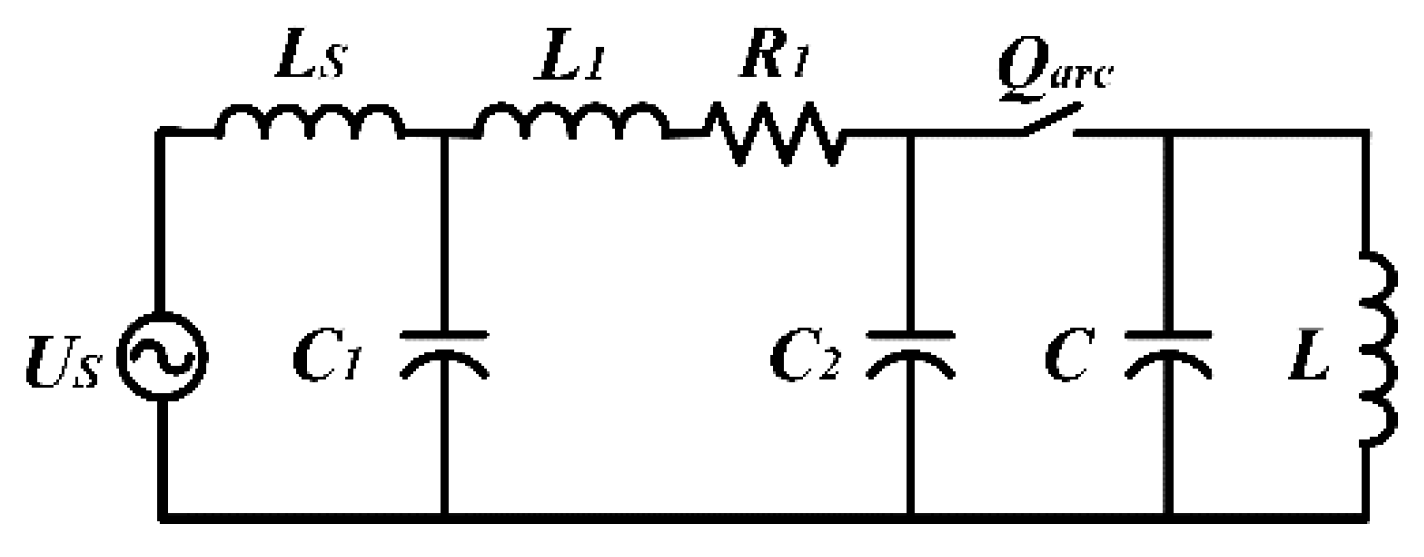
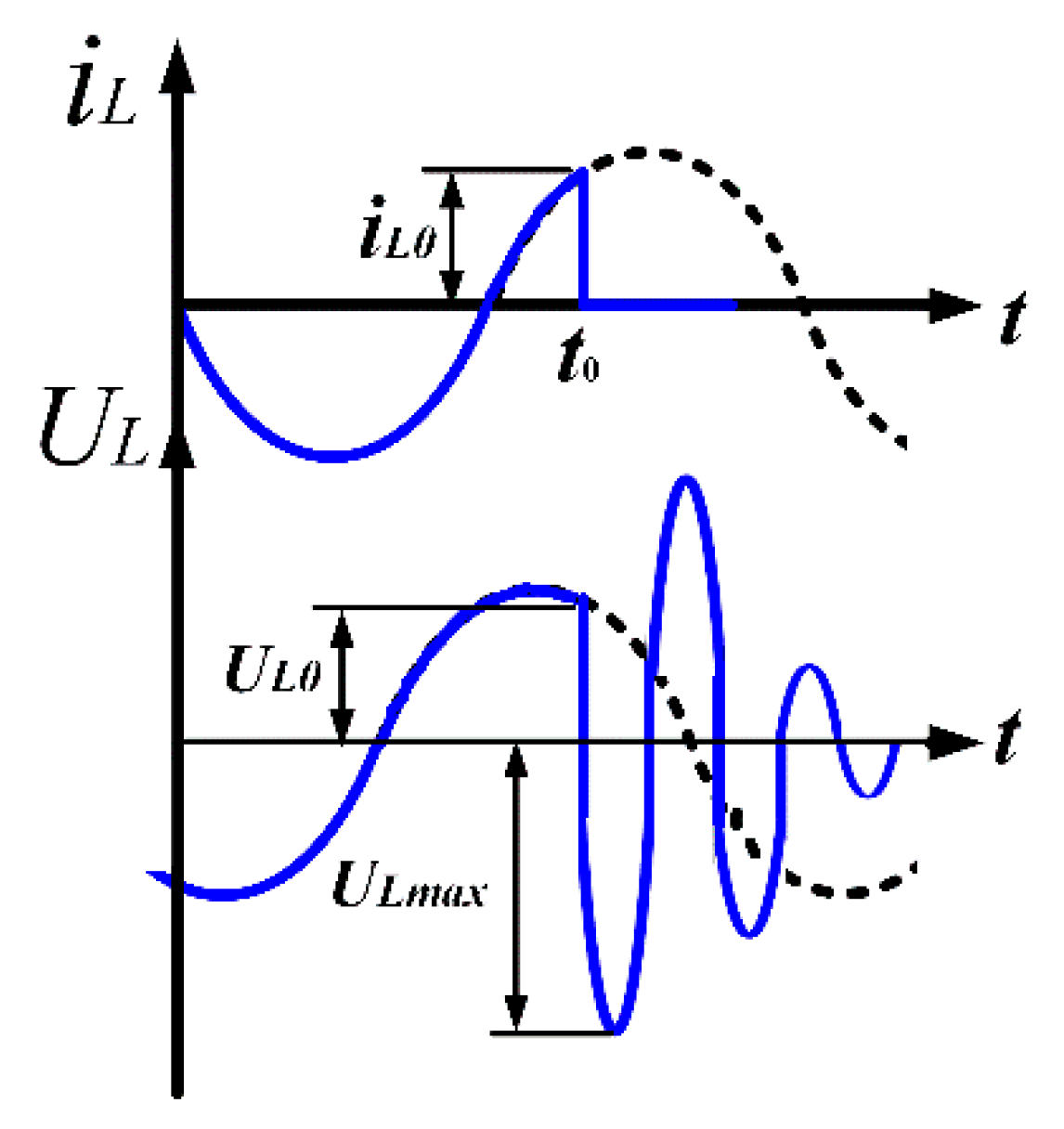
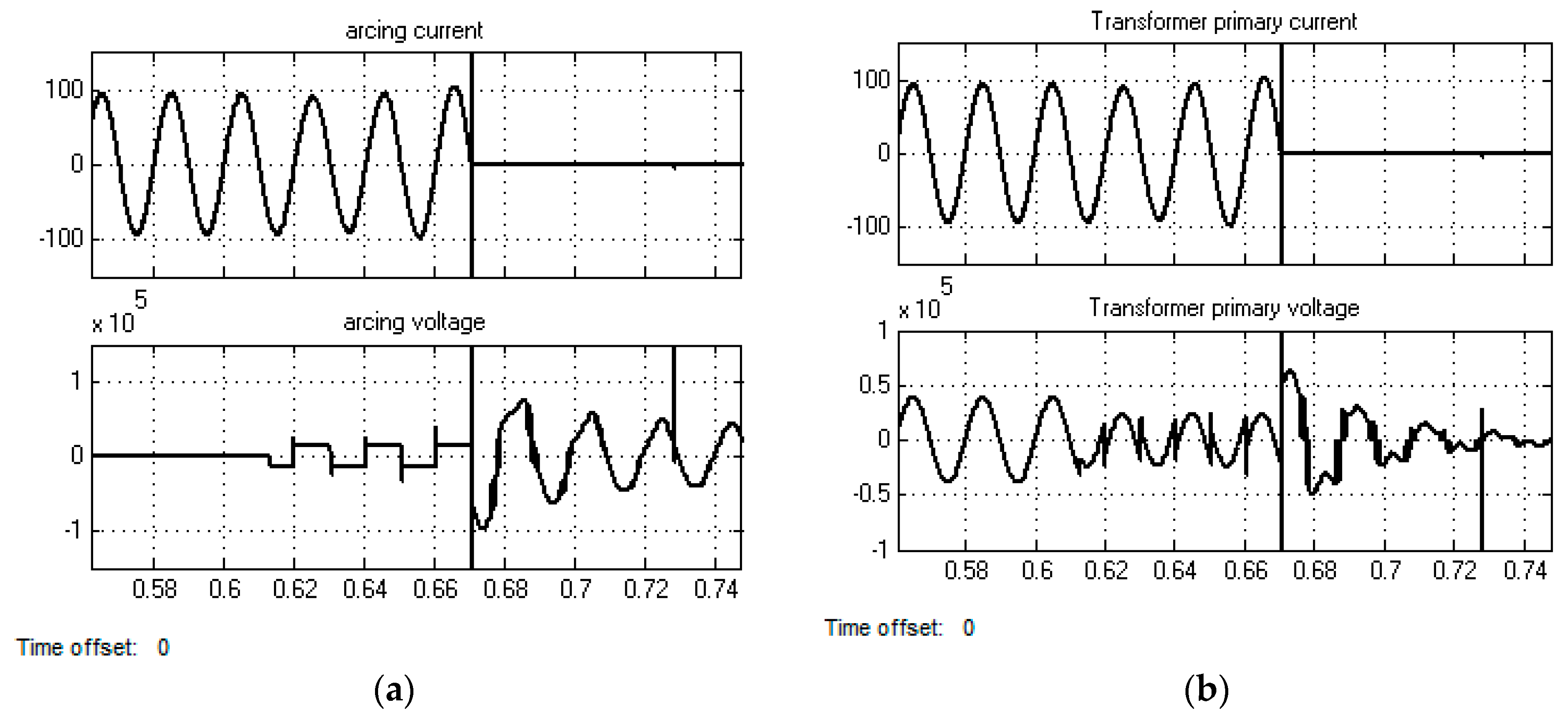


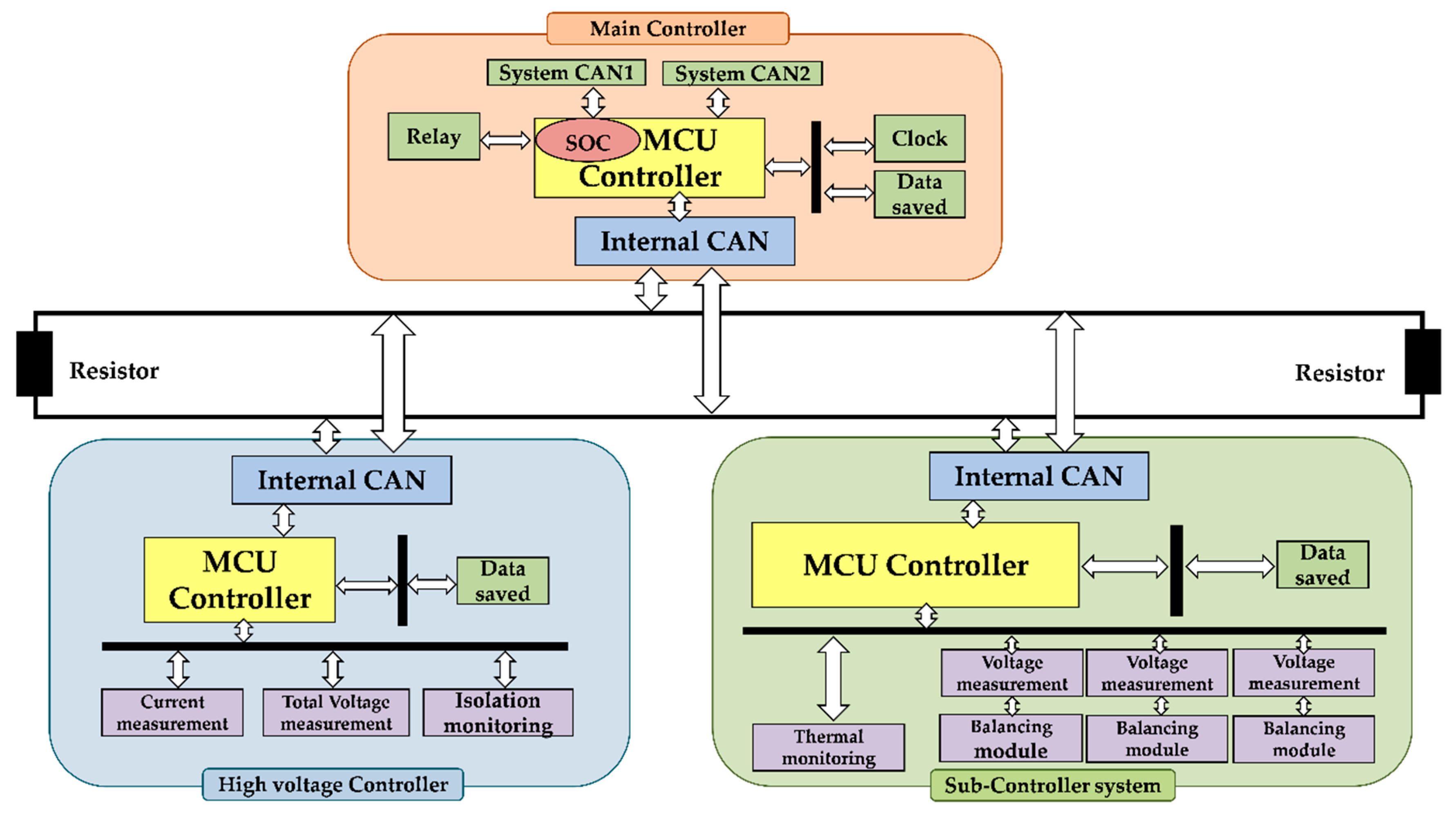


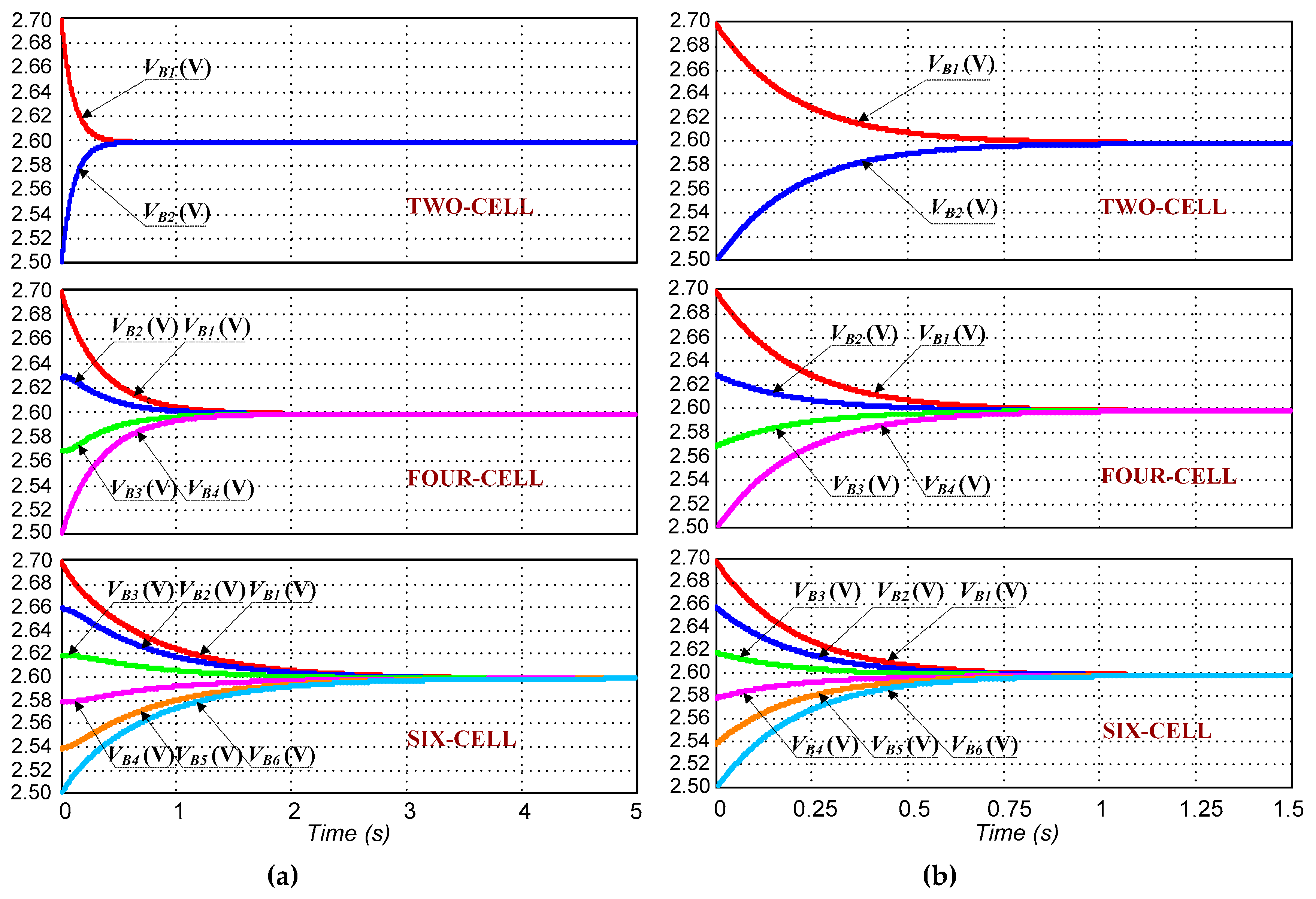

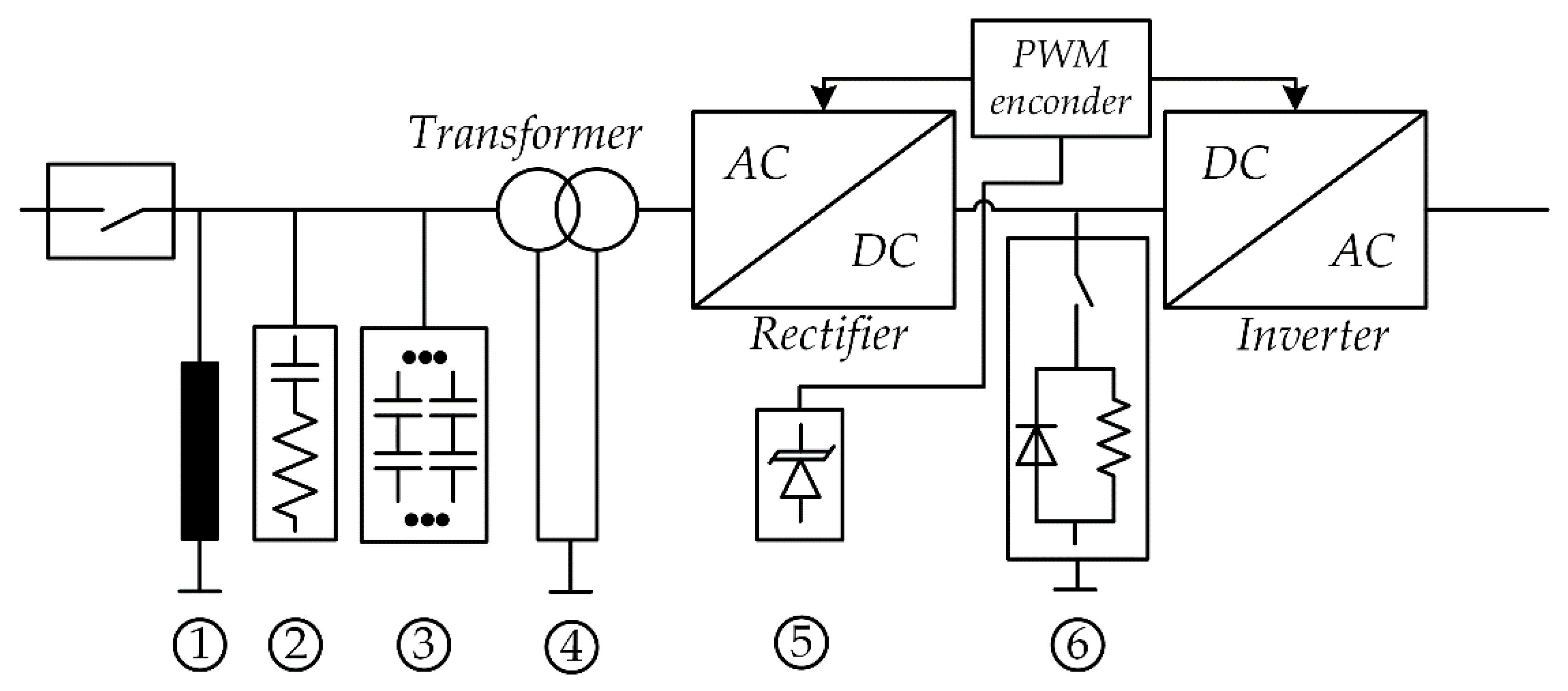
| Each supercapacitor capacity | 350 F |
| Number of supercapacitor cells | 2280 |
| Supercapacitor internal resistance | 8 mΩ |
| Supercapacitor rated voltage | 550 V |
| Supercapacitor initial voltage | 530 V |
| Reference | Methods | Features |
|---|---|---|
| [28] | Crowbar circuit | a. Protect the auxiliary railway power supply from catenary transient overvoltage. b. Behaves like a voltage limiter within a prescribed hysteresis band. |
| [29] | Surge arresters | a. Protect the systems from lightening overvoltage and switching overvoltage. b. Dependent on the value of their earth resistance. |
| [30] | Grounding | a. Mitigates the voltage surge across a car-body, especially through paralleling the capacitance besides grounding the resistors. |
| [21] | Transient voltage suppressor (TVS) | a. Adopt the TVS to suppress the overvoltage in a high-speed electric multiple units system excited by pantograph arcing and traction current flowing through the train body. |
| [24] | Resistor-capacitor (RC) absorption circuit | a. Protect the systems from high frequency switching transient overvoltage. b. Dissipate electric power during normal operation. |
| Proposed Method | Supercapacitor systems | a. Adsorb the excessive inductive energy of the locomotive transformer. b. Provide instantaneous power compensation to overcome the voltage fluctuation of the traction power supply. |
© 2019 by the authors. Licensee MDPI, Basel, Switzerland. This article is an open access article distributed under the terms and conditions of the Creative Commons Attribution (CC BY) license (http://creativecommons.org/licenses/by/4.0/).
Share and Cite
Xu, C.; Chen, Z.; Cheng, K.W.E.; Wang, X.; Ho, H.F. A Supercapacitor-Based Method to Mitigate Overvoltage and Recycle the Energy of Pantograph Arcing in the High Speed Railway. Energies 2019, 12, 1214. https://doi.org/10.3390/en12071214
Xu C, Chen Z, Cheng KWE, Wang X, Ho HF. A Supercapacitor-Based Method to Mitigate Overvoltage and Recycle the Energy of Pantograph Arcing in the High Speed Railway. Energies. 2019; 12(7):1214. https://doi.org/10.3390/en12071214
Chicago/Turabian StyleXu, Cuidong, Zhu Chen, Ka Wai Eric Cheng, Xiaolin Wang, and Ho Fai Ho. 2019. "A Supercapacitor-Based Method to Mitigate Overvoltage and Recycle the Energy of Pantograph Arcing in the High Speed Railway" Energies 12, no. 7: 1214. https://doi.org/10.3390/en12071214
APA StyleXu, C., Chen, Z., Cheng, K. W. E., Wang, X., & Ho, H. F. (2019). A Supercapacitor-Based Method to Mitigate Overvoltage and Recycle the Energy of Pantograph Arcing in the High Speed Railway. Energies, 12(7), 1214. https://doi.org/10.3390/en12071214






